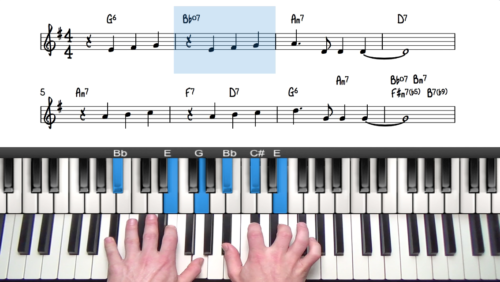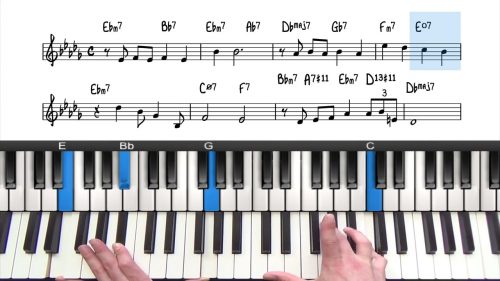How Insensitive Part 2
In this section of the tutorial, we are going to enhance the melody and add some rhythmic devices into our left hand to introduce the Bossa Nova feel and groove.
We will keep in simple in the first 16 bars and then in the second half of the tune will will add in a bass line outlining the half beat in our left hand.
Playing solo Bossa Nova is also an excellent finger strengthening exercise.
You may be aware that the 3^rd^ and 4^th^ fingers share a tendon and do not naturally move independently of each other. This is why the 4^th^ finger is inherently weaker than the others.
If you put your hand flat on the table and try to lift up each finger individually, you will see that the fourth is much more difficult to lift on it’s own.
Playing solo bossa nova piano is great exercise to strengthen the 4^th^ finger.
There’s also many classical etudes. Again to mention Chopin, his etude Opus 10. #2 was written to address this weakness and improve flexibility in the 4^th^ finger.
I’d recommend becoming comfortable with the material in this lesson before watching the final part of this tutorial.
Practice Tips
- Listen to a lot of Bossa Nova music.
- Master the ballad arrangement from the previous lesson to gain a better understanding of the melody and chord changes.
- Internalize left-hand play on beats 1 and 3.
- Play solo bossa nova piano to strengthen the 4th finger.
- Become comfortable with the material from this lesson before moving on to the final part of this tutorial.




Hi Hayden, this is a really really great lesson on this beautiful song, and I could play around with it for months, and it already sounds pretty nice when I play it with Rhodes-like effect on my piano when the notes are more connected without a pedal, however with grand piano, it still sounds a bit clanky and uncontinous… Do you have a lesson on how to connect the notes without sustain pedal? You usually play the pieces without pedal, even if it is not a bossa, I think. Or your piano is sustaing the notes more then mine? 🙂 Does it require any trick or just more practice?
Hi Gergely,
Good question!
Bossa is not my speciality, but from what I do know, the sustain pedal should be used very minimally, if at all. With this song, I found it difficult to play the voicings I wanted to play, and not use any sustain pedal. Perhaps it rubbed off from my ballad style where I use the pedal a lot.
We don’t currently have any lessons on pedal usage, but it’s something we can certainly cover in future. I think it would be nice to cover it from the angle of Bossa Nova, as mentioned the style should be played without pedal and so it’s the perfect application, or genre, to demonstrate. We will have more Latin teachers soon and it would be good to get the insight from someone who specialises and is passionate about Bossa and Latin.
I will keep you posted with any developments on this front.
Cheers!
Hayden
ps. And yes, the electric keyboard I was using at the time had an issue with the pedal. The issue just showed up on the audio recording of the lesson, not what I was actually hearing whilst playing. Instead of it functioning like a normal pedal, at times it would become an on/off sustain switch! So every time I pressed the pedal, it created constant sustain until I pressed it again. I recorded a few lessons without realising what was happening and replaced it when I figured it out. A pianists nightmare! 😄
🙂 Cheers!